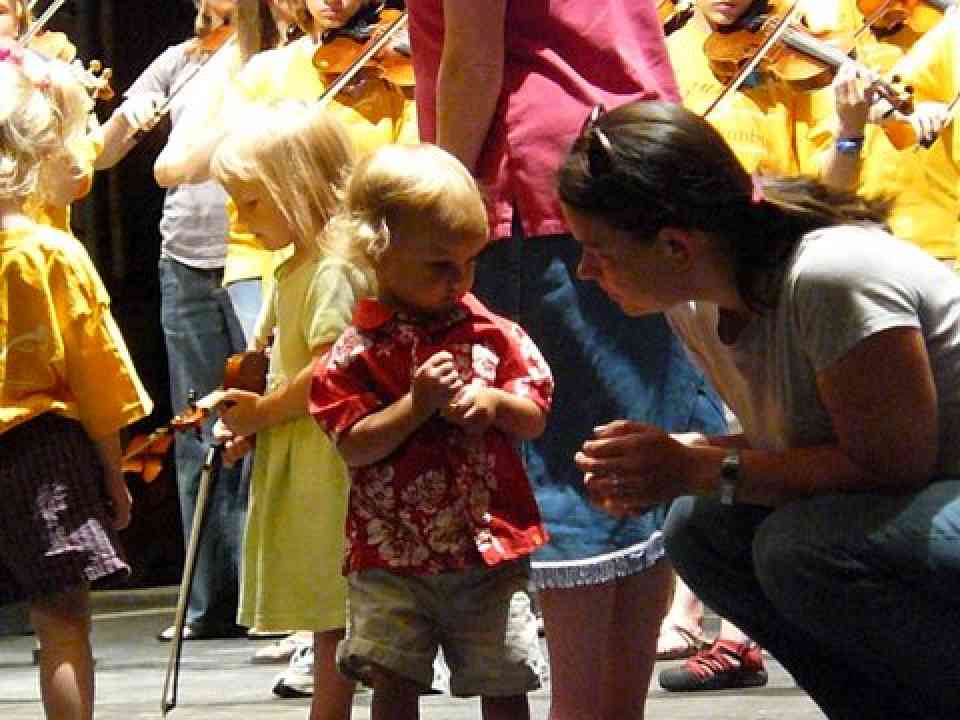
Violin group class at Suzuki Music Columbus
Discipline, related to the word “disciple,” implies learning from a master teacher.
Like it or not, we parents are our children’s primary master teachers. Expanding our repertoire of teaching techniques will enable us to tailor our choices to our child’s age, temperament, learning history and to our own values. Perhaps some of these options will work for you in your family.
-
Ignore the problem behavior if it is not dangerous. Paying attention simply reinforces it so that it is more likely to happen in the future.
-
Redirect the child’s attention to another activity.
-
Restructure the environment so as to remove or cut down on temptations for misbehavior. This is commonly called “child-proofing the environment” and is especially appropriate for use with young children.
-
Pay attention to the positives. Try to reward constructive behavior while ignoring troublesome behavior.
-
Reexamine your expectations. Is it possible that the child’s behavior is age appropriate after all? Sometimes behaviors which frustrate parents—such as crying or wanting to “do it myself”—are a normal part of the learning process at a particular stage of development.
-
Use a time-out procedure. Calmly remove the out-of-control child to a boring but safe location. Briefly tell the child why the offending behavior is not acceptable and that he must sit, doing nothing, in the time-out location until you say he may leave. One minute for each year of a child’s age is a frequently-recommended guideline in deciding how long to leave a child in time-out. Any yelling, arguing or tantruming results in the timer being restarted. At the conclusion of time-out, let the matter drop-no nagging, lecturing, or recrimination. Expect to be tested at first. Remaining firm and calm is essential.
-
Examine your own behavior. Is it possible that the child is responding to your own unclear expectations, confusing communication, threatening attitude or inconsistency? If so, a change of pa-rental behavior is probably the quickest route to a change in the child’s behavior.
-
Less is more. When children become disruptive, it’s tempting for the parent or caregiver to respond in kind-with loud voice, aggressive language and non-verbal signs of physical tension. Unfortunately, this often makes matters worse. Instead, find your calm center, establish eye contact, and lower your voice. Calm has a wonderful way of breeding calm.
-
Touch. There are many kinds of touch that can help children restore order to their lives-a gentle hand on the shoulder, a stroke of the hair, a back rub. In our low-touch, fearful society, gentle touch carries within it a largely-overlooked power.
-
Name the unacceptable behavior. Although this seems obvious, sometimes parents simply assume that the child knows what she did wrong or that an admonition like “be nice” will provide enough direction. Don’t assume. Instead, specifically state what is wrong and why. For example, a parent might say, “I will not allow you to stab your brother with your bow. That hurts.”
-
Examine the environment for unacceptable behavior models the child may be imitating. Did he hear that kind of foul language from Dad, from TV, from a friend? Does Mom pout and slam doors when she gets mad, too? With embarrassing accuracy, our children have a knack for emulating our most negative behaviors. Perhaps the child’s models will need to change so the child may change more easily.
-
Permit logical consequences. Forgetting a homework assignment logically leads to a poor grade on that assignment. Spending the allowance right away logically leads to not having money to buy something she wants later in the week. Don’t rescue the child. Let her learn from the consequences, with no “I-told-you-so’s.”
-
Reward positive behavior with a tangible reinforcer, like a sticker or a favorite snack. We adults work for reinforcers (money) and children will too.
-
Give a choice, but be sure both alternatives are acceptable to you. “You may practice now or wait until after dinner. Which do you prefer? Not practicing is not an option.
-
Invite the child to help figure out how to deal with the negative behavior. Sometimes children, especially older ones, have surprisingly wise suggestions. Explain the problem and “Katie, for the last two or three weeks you’ve been putting off doing your homework and then wanting to stay up past your bedtime to finish it. Now you’re starting to com¬plain of being tired all the time. How would you suggest dealing with this problem of procrastinating on home-work?”
-
Hold a family meeting if other members are involved in or affected by the problem. Brainstorm solutions and, in consultation with the child, pick an approach that sounds helpful.
-
Remove a privilege as a consequence to the behavior. Try to pick a privilege that is meaningful to the child and has some logical connection to the behavior. “If you do not get your home-work done by 10:00 P.M., you will not be permitted to watch TV the following night because you haven’t used your time wisely.”
-
Tell the child directly what you observe, think, feel, and want, using “I” statements. “When I see you abuse your instrument like that, I feel angry and worried about what damage you might do. I think you’re old enough to find a better way of expressing your frustration. What ideas do you have?”
-
Use gentle—not berating—humor to put the situation in a new perspective for the child and yourself. Well-timed humor can turn a raging bull of a child into a laughing hyena faster than ten minutes of reasoning together.
-
Develop a nonverbal warning system for repetitive bad habits that the child may do without being aware of them. For example, when Mom tugs her earlobe (like Carol Burnett used to do), that might mean, “Oops! You’re biting your nails again.” Scratching the head with two fingers crossed might mean, “Did you know that you’re chewing with your mouth open?” Children who hate nagging will often accept nonverbal re-minders as a replacement.
-
Keep a behavior count of the problem behavior and let the child establish a goal of how much to decrease that behavior that week. Decide together on a treat, such as a special activity together, if the goal is met.
-
Help the child substitute an acceptable behavior for an unacceptable behavior. This strategy is built on the principle that it’s unwise to take a behavior away without providing a substitute.
-
Try to establish some physical links to emotional states and specific behaviors. For example, preschoolers can be taught that a certain piece of music means it’s time to get quiet and calm. The lullaby and bedtime story routine means it’s time to rest. Ringing a bell might mean it’s time to come practice.
-
As a family, establish a list of rules and consequences. Don’t make too many, and be sure to renegotiate them as the children get older. Making rules and consequences together helps children feel a sense of ownership and assures parents that children truly do know the rules and consequences since they helped make them.
-
Look for causes and deal with them. For example, if a child has a tantrum when asked to practice, look at the context. Has his play been interrupted with no opportunity for a transition? If so, the tantrum might be prevented next time by giving the child a five minute warning.
As our children’s “master teachers,” we must teach with consistency, wisdom and love from our expanded discipline repertoire.







